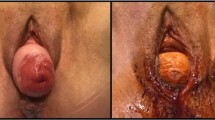Abstract
Posterior intravaginal slingplasty (IVS) is a technique used for the treatment of apical prolapse. Type III meshes have been mostly used with this technique. In this article, a case of bilateral gluteo-vaginal sinus tract formation that complicated a posterior vaginal slingplasty with a type III mesh is presented. At 3 months follow-up, the patient complained for bulking through the vagina, continuous offensive vaginal discharge, and constant pain at the buttocks. She had prolapse recurrence, and there was defective healing at the gluteal entry points of the posterior IVS. Ten months after the initial surgery, she underwent a laparotomic subtotal hysterectomy and sacrocervicopexy with prolene type I mesh. At the same time, the posterior mesh was removed allowing the surgeon to discover communication of the canal of the mesh extending from gluteal incisions to the vagina epithelium. The sinus tract was managed surgically with excision of the surrounding tissues. There was no recurrence or other complications at 2 months follow-up.


Similar content being viewed by others
References
Deprest J, Zheng F, Konstantinovic M, Spelzini F, Claerhout F, Steensma A, Ozog Y, de Ridder D (2006) The biology behind fascial defects and the use of implants in pelvic organ prolapse repair. Int Urogynecol J 17:S16–S25
Slack M, Sandhu JS, Staskin DR, Grant RC (2006) In vivo comparison of suburethral sling materials. Int Urogynecol J 17:106–110
Dwyer PL (2006) Evolution of biological and synthetic grafts in reconstructive pelvic surgery. Int Urogynecol J 17:S10–S15
Bafghi A, Benizri EL, Trastour C, Benizri EJ, Michiels JF, Bongain A (2005) Multifilament polypropylene mesh for urinary incontinence: 10 cases of infections requiring removal of the sling. Br J Obstet Gynaecol 112:376–378
Meschia M, Pifarotti P, Bernasconi F, Magatti F, Viganò R, Bertozzi R, Barbacini P (2006) Tension-free vaginal tape (TVT) and intravaginal slingplasty (IVS) for stress urinary incontinence: a multicenter randomized trial. Am J Obstet Gynecol 195:1338–1342
Kim JC, Chung BS, Choi JB, Lee JY, Lee KS, Park WH, Choo MS (2007) A safety and quality of life analysis of intravaginal slingplasty in female stress incontinence: a prospective, open label, multicenter, and observational study. Int Urogynecol J Pelvic Floor Dysfunct (in press; PMID: 17333435)
Siegel AL, Kim M, Goldstein M, Levey S, Ilbeigi P (2005) High incidence of vaginal mesh extrusion using the intravaginal slingplasty sling. J Urol 174:1308–1311
Papa Petros PE (2001) Vault prolapse II: restoration of dynamic vaginal supports by infracoccygeal sacropexy, an axial day-case vaginal procedure. Int Urogynecol J 12:296–303
Beer M, Kuhn A (2005) Surgical techniques for vault prolapse: a review of the literature. Eur J Obstet Gynecol Reprod Biol 119:144–155
Kenton K, Mueller E (2005) Surgical repair of the middle compartment. Clin Obstet Gynecol 48:691–703
Miklos JR, Moore RD, Kohli N (2002) Laparoscopic surgery for pelvic support defects. Curr Opin Obstet Gynecol 14:387–395
Maher C, Baessler K, Glazener CM, Adams EJ, Hagen S (2004) Surgical management of pelvic organ prolapse in women. Cochrane Database Syst Rev 18(4):CD004014
Petros PE (1997) New ambulatory surgical methods using an anatomical classification of urinary dysfunction improve stress, urge and abnormal emptying. Int Urogynecol J Pelvic Floor Dysfunct 8:270–277
Neuman M, Lavy Y (2007) Posterior intra-vaginal slingplasty for the treatment of vaginal apex prolapse: medium-term results of 140 operations with a novel procedure. Eur J Obstet Gynecol Reprod Biol (in press; PMID: 17267096)
Jordaan DJ, Prollius A, Cronje HS, Nel M (2006) Posterior intravaginal slingplasty for vaginal prolapse. Int Urogynecol J 17:326–329
Mattox TF, Moore S, Stanford EJ, Mills BB (2006) Posterior vaginal sling experience in elderly patients yields poor results. Am J Obstet Gynecol 194:1462–1466
Neuman M, Lavy Y (2007) Conservation of the prolapsed uterus is a valid option: medium term results of a prospective study with the posterior intravaginal slingoplasty operation. Int Urogynecol J Pelvic Floor Dysfunct 18:889–993
Sivaslioglu AA, Gelisen O, Dolen I, Dede H, Dilbaz S, Haberal A (2005) Posterior sling (infracoccygeal sacropexy): an alternative procedure for vaginal vault prolapse. Aust N Z J Obstet Gynaecol 45:159–160
Biertho I, Dallemagne B, Dewandre JM, Markiewicz S, Monami B, Wahlen C, Weerts J, Jehaes C (2004) Intravaginal slingplasty: short term results. Acta Chir Belg 104:700–704
Farnsworth BN (2002) Posterior intravaginal slingplasty (infracoccygeal sacropexy) for severe post hysterectomy vaginal vault prolapse—a preliminary report on efficacy and safety. Int Urogynecol J Pelvic Floor Dysfunct 13:4–8
Baessler K, Hewson AD, Tunn R, Schuessler B, Maher CF (2005) Severe mesh complications following intravaginal slingplasty. Obstet Gynecol 106:713–716
Riva DDR (2005) Posterior IVS procedure (infracoccygeal sacropexy) in the treatment of hysterocele and vaginal vault prolapse. Int Urogynecol J 16:S77(Abstract 194)
Hilger WS, Cornella JL (2005) Rectovaginal fistula after posterior intravaginal slingplasty and polypropylene mesh augmented rectocele repair. Int Urogynecol J 17:89–92
Author information
Authors and Affiliations
Corresponding author
Rights and permissions
About this article
Cite this article
Mikos, T., Tsalikis, T., Papanikolaou, A. et al. Gluteo-vaginal sinus formation complicating posterior intravaginal slingplasty followed by successful IVS removal. A case report and review of the literature. Int Urogynecol J 19, 449–452 (2008). https://doi.org/10.1007/s00192-007-0454-1
Received:
Accepted:
Published:
Issue Date:
DOI: https://doi.org/10.1007/s00192-007-0454-1




